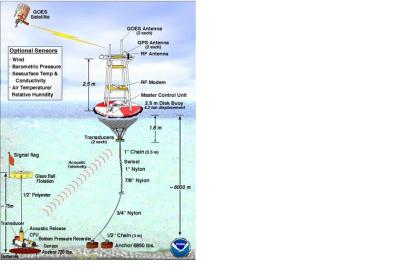The ocean-based tsunami detection system, known as the deep-ocean assessment and reporting of tsunamis (DART), which today sent warnings to residents on the west coast of the United States and Hawaii (as well as more than 50 other countries) is an unreliable system, according to 2010 report.
The DART system was developed by the National Oceanic and Atmospheric Administration in 2001. It consists of a bottom pressure recorder anchored to the seafloor and a moored surface buoy. Data from the pressure recorder is transmitted to the buoy via an acoustic link, and the buoy sends the data to a satellite that communicates with a control station. Most of the buoys are located in the Pacific Ocean where a tsunami landfall is thought to be more likely. Other locations include the Atlantic Ocean and Carribean.
Of the 39 stations deployed in 2008 only an estimated 60 percent were operational by 2009. The report, issued by the National Research Council of the National Academy of Sciences, concluded that the buoy stations, despite their technological achievements, may not be a feasible long term solutions for providing improved early warning and real-time reporting of tsunamis.
For additional information also see: http://www.technologyreview.com/blog/editors/26505/

